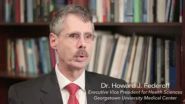(Press-News.org) (March 10, 2014) The gut microbiota contains a vast number of microorganisms from all three domains of life, including bacteria, archaea and fungi, as well as viruses. These interact in a complex way to contribute towards both health and the development of disease — interactions that are only now being elucidated thanks to the application of advanced DNA sequencing technology in this field.
"Using novel metagenomic approaches, scientists are at last beginning to characterize the taxonomic abundance and community relationships not only of bacteria, but also the other microbes that inhabit the gut environment,"1 says Professor Gary Wu, University of Pennsylvania, Philadelphia. "This exciting work is bringing us one step closer to understanding the importance of microbial diversity in intestinal health and disease and could ultimately lead to new ways of diagnosing and treating gastrointestinal (GI) disease."
His talk was one of the topics presented at the Gut Microbiota for Health World Summit in Miami, FL, USA. On March 8-9, 2014, internationally leading experts discussed the latest advances in gut microbiota research and its impact on health.
The microorganisms that inhabit the gut can be broadly divided into prokaryotes (bacteria and archaea), bacteriophages (viruses that infect prokaryotes), eukaryotic viruses, and the meiofauna (microscopically small benthic invertebrates that live in both marine and fresh water environments — primarily fungi and protozoa).1 Of these, bacteria have been the most extensively studied. The gastrointestinal tract is now considered one of the most complex microbial ecosystems on earth and understanding how the multiple communities interact presents both opportunities and challenges.
"We have known for some time that the bacteria in the gut play an important role in both health and disease," says Prof. Wu. "It is also now becoming clear that the non-bacterial microbiota interacts in a complex way with the bacterial microbiota to contribute to these processes."
Viruses in the gut
The most common viruses in the gut are the bacteriophages. These rapidly-evolving viruses can outnumber bacteria by a factor of 10 to one; they infect and destroy bacterial cells and have the ability to transfer genetic material from one bacterium to another, with potentially profound implications for GI health and disease.
"There is a predator–prey relationship between bacteriophages and bacteria that may play a role in altering the bacterial microbiota in conditions such as inflammatory bowel diseases (IBD)," says Prof. Wu. "The fact that bacteriophages induce immune responses in bacteria and may also transmit genomic material into bacteria that may alter their function makes these viruses extremely important and we need to know much more about them."
Meiofauna in the microbiota
DNA sequencing techniques have also confirmed the presence of commensal meiofauna in the GI tract that may be important in promoting health and disease.1 Certain types of meiofauna (e.g. helminths and Blastocystis) are thought to protect against IBD by suppressing inflammation, and others believe that increased fungal diversity may contribute to GI diseases, including IBD.
"Decreases in fungal diversity have been shown to correlate with an increase in healthy bacterial colonisation following probiotic therapy, suggesting niche competition between fungi and bacteria," says Prof. Wu. "This effect is also evident in the development of mucosal Candida infection following antibiotic treatment."
Non-bacterial microbes and the future
Prof. Wu and others believe that the importance of trans-domain interactions in health and disease are only just beginning to emerge. By studying the complex relationships between bacterial and non-bacterial microbes in the gut, it is hoped that a greater understanding of pathogenic mechanisms will be gained, leading ultimately to novel approaches to diagnosis and treatment.
INFORMATION: The microbial communities that reside in the human gut and their impact on human health and disease are one of the most exciting new areas of research today. To address the most recent advances in this rapidly developing field, scientists and health-care professionals from all over the world came together at the Gut Microbiota for Health World Summit in Miami, Florida, USA, on March 8-9, 2014. The meeting was hosted by the Gut Microbiota & Health Section of the European Society of Neurogastroenterology and Motility (ESNM) and the American Gastroenterological Association (AGA) Institute, with the support of Danone.
1 Norman JM , Handley SA , Virgin HW. Kingdom-agnostic Metagenomics and the Importance of Complete Characterization of Enteric Microbial Communities. Gastroenterology. 2014 Feb 5. pii: S0016-5085(14)00154-1. doi: 10.1053/j.gastro.2014.02.001. [Epub ahead of print]
About the Gut Microbiota For Health Experts Exchange website
The http://www.gutmicrobiotaforhealth.com Experts Exchange, provided by the Gut Microbiota & Health Section of ESNM, is an online platform for health-care professionals, scientists, and other people interested in the field. Thanks to being an open, independent and participatory medium, this digital service enables a scientific debate in the field of gut microbiota.
Connected to http://www.gutmicrobiotaforhealth.com, the Twitter account @GMFHx, animated by experts, for experts from the medical and scientific community, actively contributes to the online exchanges about the gut microbiota. Follow @GMFHx on Twitter. You can follow the Twitter coverage of the event using #GMFH2014
About the Gut Microbiota & Health Section of ESNM
ESNM stands for the European Society of Neurogastroenterology and Motility, a member of United European Gastroenterology (UEG). The mission of the ESNM is to defend the interests of all professionals in Europe involved in the study of neurobiology and pathophysiology of gastrointestinal function. The Gut Microbiota & Health Section was set up to increase recognition of the links between the gut microbiota and human health, to spread knowledge and to raise interest in the subject. The Gut Microbiota & Health Section is open to professionals, researchers, and practitioners from all fields related to gut microbiota and health. http://www.esnm.eu/gut_health/gut_micro_health.php?navId=68
About the AGA
The American Gastroenterological Association is the trusted voice of the GI community. Founded in 1897, the AGA has grown to include more than 16,000 members from around the globe who are involved in all aspects of the science, practice and advancement of gastroenterology. The AGA Institute administers the practice, research and educational programmes of the organisation. http://www.gastro.org
About Danone and Gut Microbiota for Health
Danone's conviction is that food plays an essential role in human health namely through the impact that the gut microbiota may have on health. That is why Danone supports the Gut Microbiota for Health World Summit and Experts Exchange web platform with the aim to encourage research and increase knowledge in this promising area, in line with its mission to "bring health through food to as many people as possible." http://www.danone.com
More than just bacteria: The importance of microbial diversity in gut health and disease
2014-03-10
ELSE PRESS RELEASES FROM THIS DATE:
IBS and bloating: When the gut microbiota gets out of balance
2014-03-10
(March 10, 2014) Irritable bowel syndrome (IBS) belongs to the most widespread diseases in Western countries, causing up to sixty per cent of the workload of gastrointestinal physicians. One of the most frequent symptoms of IBS is bloating, which reduces quality of life considerably as patients perceive it as particularly bothersome. For quite a long time, IBS was believed to be a primarily psychological condition.
"Contrary to this view, recent findings suggest that IBS is linked to clearly detectable gut microbiota alterations. Additionally, bloating can be related ...
Mapping the behavior of charges in correlated spin-orbit coupled materials
2014-03-10
CHESTNUT HILL, MA (March 10, 2014) – In a relatively recently discovered class of materials, known as spin-orbit Mott insulators, theorists have predicted the emergence of new properties at points just beyond the insulating state, when electronic manipulation can transform these compounds into conducting metals.
A better understanding of electrons near this transition, theorists have predicted, could allow these new Mott insulators to pave the way to discoveries in superconductivity, new topological phases of matter, and new forms of unusual magnetism.
What scientists ...
Farm salmon pose clear reproductive threat to wild gene pools
2014-03-10
Farmed salmon show full reproductive potential to invade wild gene pools and should be sterilised - according to new research from the University of East Anglia (UEA).
Findings published today reveal that, while farmed salmon are genetically different to their wild counterparts, they are just as fertile. This is important information because millions of farmed salmon escape into the wild – posing threats to wild gene pools.
Lead Researcher Prof Matt Gage from UEA's school of Biological Sciences said: "Around 95 per cent of all salmon in existence are farmed, and domestication ...
UEA research reveals 4 new man-made gases in the atmosphere
2014-03-09
Scientists at the University of East Anglia have identified four new man-made gases in the atmosphere – all of which are contributing to the destruction of the ozone layer.
New research published today in the journal Nature Geoscience reveals that more than 74,000 tonnes of three new chlorofluorocarbons (CFCs) and one new hydrochlorofluorocarbon (HCFC) have been released into the atmosphere.
Scientists made the discovery by comparing today's air samples with air trapped in polar firn snow – which provides a century-old natural archive of the atmosphere. They also looked ...
Blood test identifies those at-risk for cognitive decline, Alzheimer's within 3 years
2014-03-09
VIDEO:
Howard J. Federoff, M.D., Ph.D., of Georgetown University Medical Center, explains a new blood test that can predict onset of MCI or Alzheimer's.
Click here for more information.
WASHINGTON — Researchers have discovered and validated a blood test that can predict with greater than 90 percent accuracy if a healthy person will develop mild cognitive impairment or Alzheimer's disease within three years.
Described in Nature Medicine published online today, the study heralds ...
Mutations in leukemia gene linked to new childhood growth disorder
2014-03-09
Mutations in a gene associated with leukaemia cause a newly described condition that affects growth and intellectual development in children, new research reports.
A study led by scientists at The Institute of Cancer Research, London, identified mutations in the DNA methyltransferase gene, DNMT3A, in 13 children.
All the children were taller than usual for their age, shared similar facial features and had intellectual disabilities. The mutations were not present in their parents, nor in 1,000 controls from the UK population.
The new condition has been called 'DNMT3A ...
First animals oxygenated the ocean, study suggests
2014-03-09
The evolution of the first animals may have oxygenated the earth's oceans – contrary to the traditional view that a rise in oxygen triggered their development.
New research led by the University of Exeter contests the long held belief that oxygenation of the atmosphere and oceans was a pre-requisite for the evolution of complex life forms.
The study, published today in the leading journal Nature Geoscience, builds on the recent work of scientists in Denmark who found that sponges – the first animals to evolve – require only small amounts of oxygen.
Professor Tim ...
In grasslands remade by humans, animals may protect biodiversity
2014-03-09
COLLEGE PARK, Maryland – A comparative study of grasslands on six continents suggests there may be a way to counteract the human-made overdose of fertilizer that threatens to permanently alter the biodiversity of the world's native prairies.
The solution is one that nature devised: let grazing animals crop the excess growth of fast growing grasses that can out-compete native plants in an over-fertilized world. And grazing works in a way that is also natural and simple. The herbivores, or grazing and browsing animals, feed on tall grasses that block sunlight from reaching ...
New bioinformatics tool to visualize transcriptomes
2014-03-09
ZENBU, a new, freely available bioinformatics tool developed at the RIKEN Center for Life Science Technology in Japan, enables researchers to quickly and easily integrate, visualize and compare large amounts of genomic information resulting from large-scale, next-generation sequencing experiments.
Next-generation sequencing has revolutionized functional genomics, with protocols such as RNA-seq, ChIP-seq and CAGE being used widely around the world. The power of these techniques lies in the fact that they enable the genome-wide discovery of transcripts and transcription ...
Sun's energy influences 1,000 years of natural climate variability in North Atlantic
2014-03-09
Changes in the sun's energy output may have led to marked natural climate change in Europe over the last 1000 years, according to researchers at Cardiff University.
Scientists studied seafloor sediments to determine how the temperature of the North Atlantic and its localised atmospheric circulation had altered. Warm surface waters flowing across the North Atlantic, an extension of the Gulf Stream, and warm westerly winds are responsible for the relatively mild climate of Europe, especially in winter. Slight changes in the transport of heat associated with these systems ...




